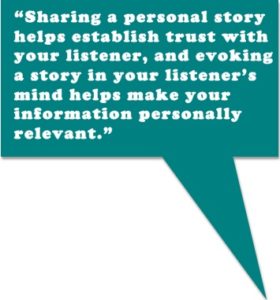See a photo of Thaler, her bio, Part 1 of this Q&A, Part 2, Part 3, and Part 4.
Q&A with Thaler Pekar, Question 5:
Q: Your background includes research in cognitive linguistics, brain imaging, and persuasive communications. In your article, “Storytelling is Only Half the Story,” you note that many leaders seek communication techniques “to inspire an audience and move people to action.” How does storytelling fit into that objective?
A: I prefer story sharing, not storytelling. Leaders must share their stories so as to evoke stories in their listener’s minds and guide them toward personal understanding of the issue and need for action. It’s a two-way, 2.0, conversation.
Sharing a personal story helps establish trust with your listener, and evoking a story in your listener’s mind helps make your information personally relevant. These are the steps through which any persuasive communicator must move in order to entice their listener to take action.
By evoking a personal story, your listener is also able to recognize their part in the solution you are proposing. Once your listener is personally engaged, they are more likely to hear and process your message, and to take the action you wish them to take.
My easy-to-remember and even easier-to-apply approach to persuasive communications is called Heart, Head & Hand™.
Heart, Head, & Hand can be used by leaders to establish trust with their audience. First, I recommend that speakers share a story that their listeners are likely to find emotionally relevant, often by sharing a personal anecdote. In this way, leaders connect with their listener’s heart.
 Only then can reasons, data, and a rationale for the leader’s message be provided. Only after connecting with the listener’s heart should leaders seek to connect to the listener’s head. [Steven Denning has profound things to say about “Reinforcing with Reasons” in The Secret Language of Leadership.]
Only then can reasons, data, and a rationale for the leader’s message be provided. Only after connecting with the listener’s heart should leaders seek to connect to the listener’s head. [Steven Denning has profound things to say about “Reinforcing with Reasons” in The Secret Language of Leadership.]
Then, true leaders give the audience something to do — they put something in their hand and invite them to be part of the solution.
Both “Storytelling is Only Half the Story,” and “Heart, Head & Hand: The Science of Communication” can be found on the Tools page of my web site.
